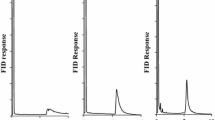Summary
Chiral compounds may be separated by gas chromatography by direct enantiomer separation on optically active stationary phases. More generally the separation can be achieved on conventional stationary phases after formation of diastereoisomeric derivatives. In this work we report on new results in enantiomer separation, indicating that hydrogen bond association is not the only kind of molecular interaction responsible for enantiomer separation. For the separation of a wide variety of chiral compounds with amino or hydroxy groups diastereo-isomeric derivatives may be formed by reaction with L-α-chlorisovaleryl chloride. The derivatives of amino acids, aliphatic and aromatic amines, amino alcohols and of some alcohols are separated in glass capillaries. Gas chromatography as a separation technique of high selectivity is specifically useful for the separation of mixtures of chemically related components with comparable molecular interactions with the molecules of the stationary phase of a gas chromatographic column. The separation of optically active compounds, particularly, requires highly efficient columns. Glass capillary chromatography is a tool that meets this standard and was applied exclusively in this work.
Similar content being viewed by others
Literature
E. Gil-Av., B. Feibush andR. Charles-Sigler, in “Gas Chromatography 1966”,A. B. Littlewood, Ed., Institute of Petroleum, London, 1972, p. 227.
W. A. Koenig, W. Parr, H. A. Lichtenstein, E. Bayer andJ. Oró, J. Chromatogr., Sci.8, 183–186.
B. Feibush, Chem. Commun. 544–545, (1971).
W. A. Koenig andG. J. Nicholson, Anal. Chem.47, 951–952 (1975).
W. A. Koenig, W. Loeffler W. H. Meyer andR. Uhmann, Chem. Ber.106, 816–825 (1973).
W. A. Koenig, C. Engelfried, H. Hagenmaier andH. Kneifel, Liebig's Ann. Chem. 2011–2020 (1976).
W. Parr, C. Yang, E. Bayer andE. Gil-Av, J. Chromatogr. Sci.8, 591–595 (1970).
J. A. Corbin, J. E. Rhoad andL. B. Rogers, Anal. Chem.43, 327–331 (1971).
W. Parr andP. Y. Howard, J. Chromatogr.71, 193–201 (1972).
U. Beitler andB. Feibush, J. Chromatogr.123, 149–166 (1976).
K. Stoelting andW. A. Koenig, Chromatographia9, 331–332 (1976).
W. A. Koenig andU. Hess, Liebig's Ann. Chem. 1977 in press.
S. Weinstein, B. Feibush andE. Gil-Av, J. Chromatogr.126, 97–111 (1976).
W. A. Koenig, W. Rahn andJ. Eyem, J. Chromatogr.133, 141–146 (1977).
W. A. Koenig, Chromatographia9, 72–73 (1976).
W. Rahn, H. Eckstein andW. A. Koenig, Hoppe-Seyler's Z. Physiol. Chem.357, 1223–1227 (1976).
B. Halpern andJ. W. Westley, Chem. Commun. 246–247 (1965).
J. Bouche andM. Verzele, J. Gas Chromatogr.6, 501–505 (1968).
S. C. J. Fu, S. M. Birnbaum andJ. P. Greenstein, J. Am. Chem. Soc.76, 6054–6058 (1954).
Author information
Authors and Affiliations
Rights and permissions
About this article
Cite this article
Koenig, W.A., Stoelting, K. & Kruse, K. Gas chroamtographic separation of optically active compounds in glass capillaries. Chromatographia 10, 444–448 (1977). https://doi.org/10.1007/BF02257358
Issue Date:
DOI: https://doi.org/10.1007/BF02257358




